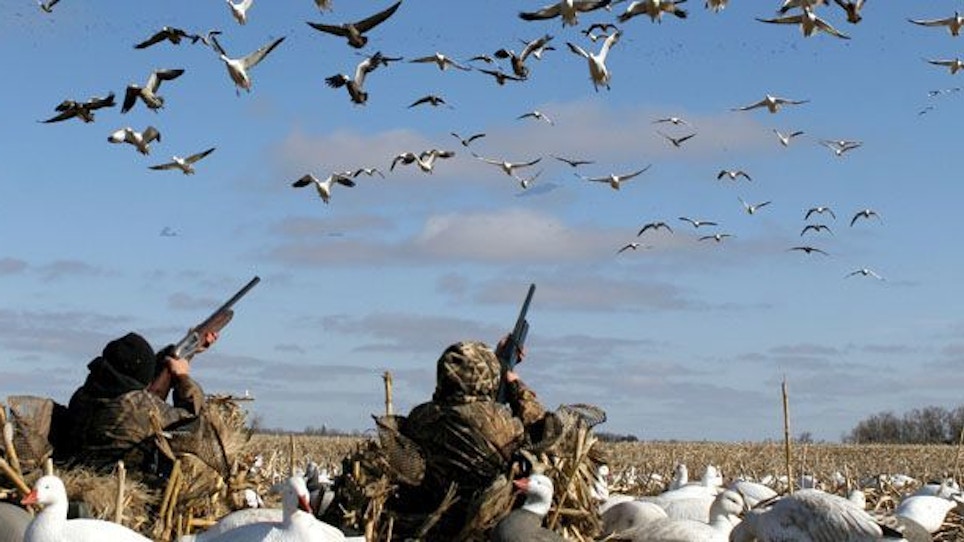The Challenge Of Hunting Snows
Hunters of the 1950s through the 1980s will remember that we once decoyed white geese by spreading newspapers, diapers or pieces of white plastic around a field. Those days are over, especially during the spring season after white geese have been hunted for several months. Diapers and newspapers are still used, but with a good spread of full-bodied decoys. White geese don't commit to a spread like other waterfowl species — they float in circles while slowly dropping and looking over the spread, meaning everything had better look to be in good order.
"Look at a flock feeding in a field and you'll see that snow geese are greedy and constantly hopping to front edges of the flock where grain is less disturbed, while feeding into the wind," Tony Vandemore, a professional waterfowling guide, says. "The downwind geese will be loose and scattered around the field. So we set up the upwind side with bulk geese to make it look like this is where the untouched food is."
Sets are laid to quarter into the wind. A straight south wind dictates placing decoys southwest to northeast or southeast to northwest, depending on what looks the best. The wind has to switch a complete 180 degrees to make changing the entire set important.
"Movement is extremely important, so we set each decoy on motion stakes," Vandemore says. "Lack of movement is a warning to incoming geese. We love windy days when decoys are moving around like live geese."
Portable blinds are set at the top end of each spread. The team leaves 10 percent of the decoys behind each blind, and 90 percent downwind. A moderate pocket of open ground is left directly in front of the blinds, with loose decoys scattered around for a landing area. Blinds are placed within a foot or two of each other. Each blind is covered with surrounding vegetation or brush. Decoys on the higher stakes are placed between each blind to attract those sharp goose eyes.
"We laid each blind behind a terrace or low spot," Tyson Keller says during our hunt. "This allowed us to be behind the shadow line when the sun rose to conceal ourselves better and to be off the horizon. We also made sure that decoys close to each blind cast a shadow on the blind instead of the blind casting a shadow on the decoy."
The day ended when a speckled goose buzzed our decoys. Specks are not in season during the spring hunt, so Keller switched on a Roy Orbison tape. The goose continued to swing around the set and then was treated to a Beatles tune, apparently another satisfying sound. Finally, just before the bird settled into the decoys, Keller put on a rap song. The goose immediately turned and started flying north at high speed. That goose might not have been the smartest, but its taste in music was certainly beyond reproach.
White Goose Stoppers
The Avery guys I hunted with shot Patternmaster extended choke systems and I shot full choke. More importantly, I had a chance to shoot Hevi-Shot Bs and was impressed at the kill-versus-wounded-bird ratio. After several seasons of shooting steel shot, I could tell the difference on my first shot.
"Hevi-Shot is twice as dense as steel shot," says Ron Petty, vice president of sales and marketing for EnvironMetal, Inc., manufacturers of Hevi-Shot. "Our shot holds energy for greater distances."
This was evident on longer shots when one to three geese dropped. Petty claims that using Hevi-Shot shells is less expensive in the long run because it only takes one shot to drop a goose or duck compared to two or three with steel shot loads. This is an important distinction for hunters who are tired of the prospect of wounded waterfowl.
The Avery group also uses two to three electronic callers with three speakers on each unit, perfectly legal during special conservation order spring seasons. Tighter-packed decoys receive more speakers than areas with fewer decoys. Geese making passes lift and immediately become more wary when one speaker is blasting louder than others. Subtle sounds from each speaker are more reassuring to the geese. Snow geese tend to work vertically on passes, so 75 percent of the speakers are pointed straight up.






